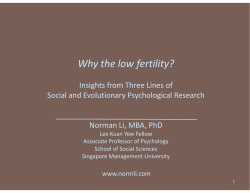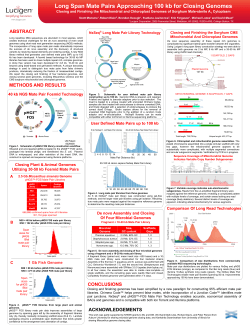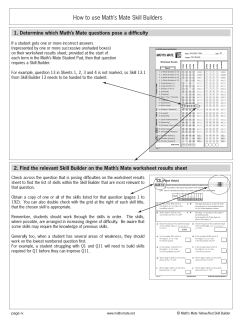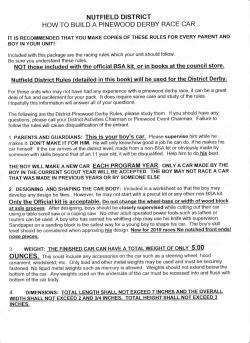
Nextera Mate Pair Sample Preparation Kit de novo
Data Sheet: Sequencing Nextera® Mate Pair Sample Preparation Kit An optimized sample preparation method for long-insert libraries that empower de novo sequencing and detection of structural variants. Highlights Figure 1: Nextera Mate Pair Workflow • Fast and Simple Mate Pair Preparation Go from DNA to libraries in less than two days with a simple tagmentation reaction and low DNA input • Dual Protocol Flexibility Gel-free and gel-plus protocols enable a range of applications, including de novo assembly and structural variation detection • Premier Data Quality Highly diverse libraries maximize data yield • End-to-End Mate Pair Solution Conveniently bundled kit includes reagents and indices for efficient mate pair preparation Introduction Mate pair library sequencing enables the generation of long-insert paired-end libraries. The Nextera Mate Pair Sample Preparation kit offers two methods, gel-free and gel-plus, to support a variety of applications and input requirements. The robust, low-input, gel-free protocol yields high-diversity libraries that enable deeper library sequencing. The size-selection process of the gel-plus protocol generates fragments with a tight size distribution for structural variation detection. Libraries prepared with the gel-plus protocol also provide sequence information for larger repeat regions, empowering de novo genome assembly. B Dual Protocol Flexibility The flexibility of Nextera Mate Pair sample preparation stems from the availability of two different size-selection options (Table 1). The gelfree protocol, which requires only 1 μg DNA, provides highly diverse mate pair libraries with a broad range of fragment sizes (Figure 2A). This protocol is ideal for routine de novo assembly of simple bacterial genomes, or for the robust generation of mate pair data on samples with limited DNA. The gel-free protocol offers a faster, simplified option with a lower DNA input requirement to streamline mate pair studies. B B B Genomic DNA (blue) is tagmented with a Mate Pair Tagment Enzyme, which attaches a biotinylated junction adapter (green) to both ends of the tagmented molecule. B B B B The tagmented DNA molecules are then circularized and the ends of the genomic fragment are linked by two copies of the biotin junction adapter. B B B B B B Circularized molecules are then re-fragmented yielding smaller fragments. Sub-fragments containing the original junction are enriched via the biotin tag (B) in the junction adapter. Simplified Mate Pair Workflow The Nextera Mate Pair protocol provides a simple mate pair workflow (Figure 1) for the preparation of sequencing-ready libraries in less than two days. Master-mixed TruSeq DNA Sample Preparation reagents reduce the number of assay steps, thereby reducing hands-on time to as little as three hours. The Nextera “tagmentation” reaction utilizes a specially engineered transposome, the Mate Pair Tagment Enzyme, to simultaneously fragment and tag the DNA sample. This simplified method only biotinylates DNA molecules at the sites of fragmentation, avoiding troublesome internal biotinylation. B B B B B B + B B After End Repair and A-Tailing, TruSeq DNA adapters (grey and purple) are then added, enabling amplification and sequencing. The Nextera Mate Pair Sample Preparation kit has a simple workflow that enables library preparation in less than two days and supports a range of fragment sizes from 2–15 Kb. The gel-plus protocol, which requires 4 μg DNA and standard agarose gels or SAGE Pippin Prep gels1, offers a more stringent size selection process. The gel-plus protocol produces libraries with tighter size distributions to facilitate structural variation detection (Figures 2B and 3). Greater control over fragment sizes is ideal for more challenging mate pair applications, such as de novo assembly of complex genomes and structural variation detection. Data Sheet: Sequencing Figure 2: Fragment Size Distribution with Dual Protocols A B 1.2 0.4 0.35 1 Frequency 0.3 0.8 0.25 0.6 0.2 0.15 A 0.4 0.1 0.2 0.05 B 1.2 0.4 0.35 0 0 0 1000 3000 5000 7000 9000 11000 13000 15000 0 Frequency Fragment Size (bp) 1 1 0.3 1000 2000 3000 4000 5000 6000 7000 8000 9000 10000 11000 0.25 0.8 Fragment Size (bp) 0.6 0.2 Panel A shows the fragment size distribution of an E. coli mate pair library prepared using the 0.15 Nextera Mate Pair gel-free protocol, resulting in a broad fragment size 0.9 distribution. Panel B shows the fragment size distribution of an E. coli mate pair library generated with the Nextera Mate Pair gel-plus protocol, using automated size 0.1 selection with the Pippin Prep platform. 0.8 0.05 Frequency 0.7 0 Highly0.5Diverse Libraries 2000 4000 3000 5000 7000 9000 11000 6000 8000 10000 12000 The Nextera Mate Pair Sample Preparation Fragment SizeKit (bp)also provides identifiable junction sequences that mark fragment ends, greatly 3 Kb 5 Kb 8 Kb simplifying informatics analysis. The presence of searchable junction sequences allows for accurate fragment identification and enables sequencing of longer read lengths, as mate pair junctions can be precisely identified and trimmed accordingly. Mate Pair Preparation Solution In addition to Nextera Mate Pair reagents, the comprehensive Nextera kit contains TruSeq DNA sample preparation reagents and indices. Nextera Mate Pair tagmentation and circularization are followed by TruSeq on-bead reactions (Figure 1), simplifying the purification workflow and reducing sample loss. This integrated solution streamlines the sample preparation workflow, maximizing sequencing efficiency with more samples per lane and enabling rapid multiplexed sequencing of small genomes. The Nextera Mate Pair kit is compatible with TruSeq DNA Sample Preparation adapter indexing, supporting 12 indices per kit for a scalable experimental approach. With all necessary reagents included in one convenient, cost-effective bundle, the Nextera Mate Pair Sample Preparation kit is the all-in-one solution for faster and simpler mate pair preparation. 13000 15000 1 0.9 0.8 0.7 Frequency 0 1000 Figure 3: Fragment Size Distribution Fragment Size (bp) 0.4 The Nextera tagmentation reaction drives the creation of highly diverse libraries0.3 (Table 2) that are compatible with all Illumina sequencing systems. Library diversity is defined as the number of unique 0.2 fragments in a given library. The Nextera Mate Pair protocol allows for 0.1 the creation of millions of unique fragments, increasing library diversity 0 fewer duplicate reads and yield greater amounts of data. to generate 0.2 0 0 0.6 0.4 0.6 0.5 0.4 0.3 0.2 0.1 0 0 2000 4000 6000 8000 10000 12000 Fragment Size (bp) 3 Kb 5 Kb 8 Kb This plot shows fragment size distributions of three E. coli mate pair libraries (3 Kb, 5 Kb, and 8 Kb) created from the same tagmentation reaction. These distributions were generated following the Nextera Mate Pair gel-plus protocol and agarose gel size-selection procedure. 0 1000 2 Data Sheet: Sequencing Ordering Information Table 1: Nextera Mate Pair Protocols Protocol DNA Input Number of Samples Size Selections Per Sample Number of Libraries Gel-Free 1 μg 48 N/A 48 Gel-Plus with Pippin Prep size selection 4 μg 12 1 12 Gel-Plus with agarose size selection 4 μg 12 Up to 4 Up to 48 Catalog No. FC-132-1001 This kit contains Nextera Mate Pair reagents and TruSeq reagents and indices. Summary Table 2: Nextera Mate Pair Library Diversity* Preparation Product Nextera Mate Pair Sample Preparation Kit With a fast and easy workflow, the Nextera Mate Pair Sample Preparation kit allows the construction of high-quality sequencing libraries in less than two days. The gel-free and gel-plus options provide flexibility for a variety of specific applications. Transposomemediated tagmentation, identifiable junction sequences, and indexing capability make Nextera Mate Pair Sample Preparation the simplest, easiest solution for mate pair applications. Input DNA Fragment Size Diversity** Nextera Mate Pair Gel-Free References 1 μg ~2–15 Kb 860 million 1. www.sagescience.com/products/pippin-prep Nextera Mate Pair Gel-Plus 4 μg ~2–4 Kb 568 million Nextera Mate Pair Gel-Plus 4 μg ~5–7 Kb 396 million Nextera Mate Pair Gel-Plus 4 μg ~6–10 Kb 102 million 2. Lander ES and MS Waterman. (1988) Genomic mapping by fingerprinting random clones: a mathematical analysis. Genomics 2(3): 231–9. www.ncbi.nlm.nih.gov/pubmed/3294162 *This table demonstrates example diversity values, with diversity reported in number of unique fragments. Actual diversities achieved with the Nextera Mate Pair kit may vary and are dependent on several factors, including DNA input quantity, DNA quality, and precise execution of the protocol. **Library diversity was calculated from the number of unique read pairs observed in a data set, using a method based on the Lander-Waterman equation.2 Illumina • 1.800.809.4566 toll-free (U.S.) • +1.858.202.4566 tel • techsupport@illumina.com • www.illumina.com For research use only © 2012 Illumina, Inc. All rights reserved. Illumina, IlluminaDx, BaseSpace, BeadArray, BeadXpress, cBot, CSPro, DASL, DesignStudio, Eco, GAIIx, Genetic Energy, Genome Analyzer, GenomeStudio, GoldenGate, HiScan, HiSeq, Infinium, iSelect, MiSeq, Nextera, NuPCR, SeqMonitor, Solexa, TruSeq, VeraCode, the pumpkin orange color, and the Genetic Energy streaming bases design are trademarks or registered trademarks of Illumina, Inc. All other brands and names contained herein are the property of their respective owners. Pub. No. 770-2012-052 Current as of 20 December 2012
© Copyright 2025




















